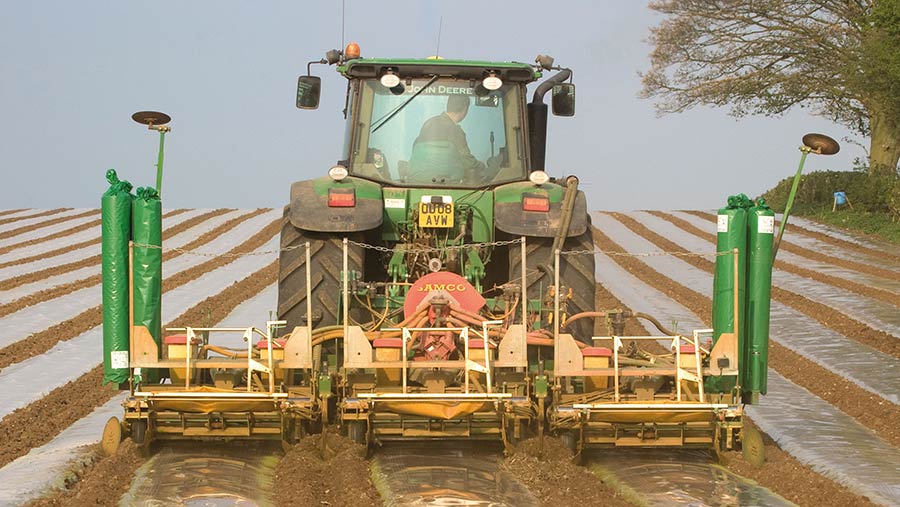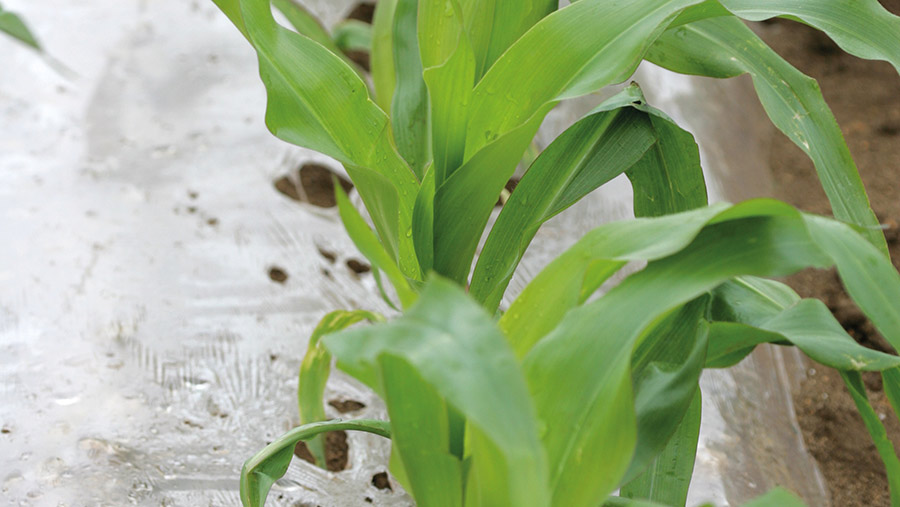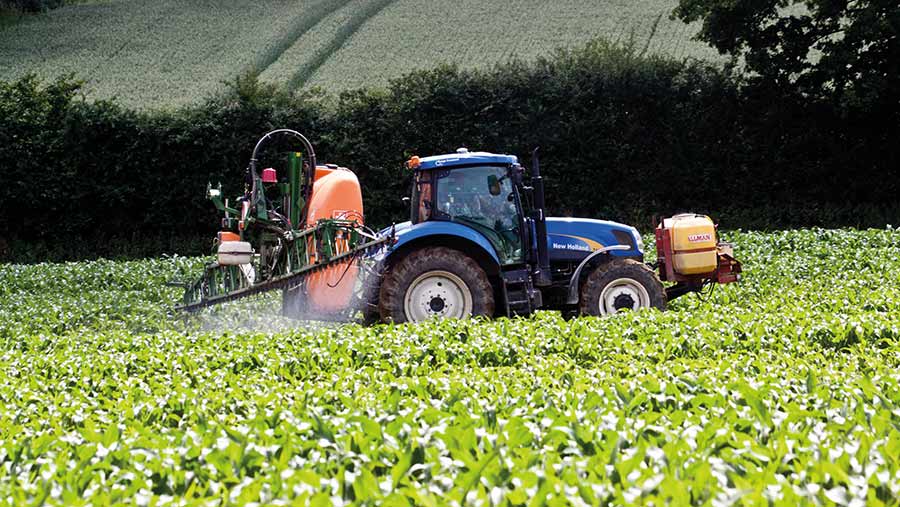Advice on growing maize under film, plus the costs
 Maize is drilled and the plastic film laid in a single operation © Tim Scrivener
Maize is drilled and the plastic film laid in a single operation © Tim Scrivener Growing maize under film could increase profit margins by more than £3,000/ha by improving the quality of the crop and increasing milk output.
Trial sites run by crop production specialist Hutchinsons last year found a 4.4t/ha difference in dry matter (DM) and a metabolisable energy (ME) difference of 0.6 between the early-maturing maize variety grown in the open and under film.
That equated to a difference of £3,084.27/ha when considering milk output at 5.3MJ/litre and at a milk price of 28p/litre (see table 3).
This is supported by research by Teagasc, which indicates that growing maize under film can yield an extra 3t DM/ha and a 6-10% starch advantage over sowing the crop conventionally.
See also: Maize growing season: Lessons from 2018 and advice for 2019
Jim Clark, an agronomist at Hutchinsons, says farmers should not get hung up on fresh weight tonnage, but should focus on the feed value including dry matter and starch level.
“A large fresh weight maize yield doesn’t necessarily equate to good quality silage,” he says.
Increasingly growers are using film as an insurance policy, he says, as it almost guarantees they will get a half-decent crop, regardless of the weather and even in less favourable areas of the UK.
“When growing in the open it is a bit like buying a lottery ticket as the grower is so reliant on the weather,” he says.
“Growing under film is the equivalent of starting plants off in a greenhouse. It accelerates the growth at the start, which can bring forward the harvest date, thereby improving the consistency and yield of the maize.
“It can be used as a management tool, to help protect the soil as crops are chopped earlier and in better weather conditions.”
Why use film?
Traditionally, film was used in marginal growing areas such as the North and West where temperatures and sunlight are less favourable.
However, now growers right across the country are using film to:
- Harvest earlier
- Reduce soil erosion
- Establish another crop after maize
- Manage bird strike
- Ensure production of a crop of a certain quality
- Produce a more consistent crop.
Step one: Variety choice
Not all varieties like film, depending on growing characteristics. This is something you should speak to your agronomist about and check whether the variety is suitable for growing under film in your area.
When choosing a variety, it is important to consider drilling dates, soil conditions and required harvest date.
Step two: Establishment
Most maize establishment under film normally takes place from mid-April to mid-May, but you can plant as early as 1 April when conditions are right.
Normally when planting maize, the soil temperature must be above 10C. However, when growing under film you can drill when it is 8-9C as the soil temperature quickly rises once covered with film.
Avoid extreme weather conditions as that can cause the seed to rot or fail to germinate.
Seedbed preparation is vital, as maize will not grow well in compacted soil. About 55% of yield is down to soil structure and drilling, so if you get that wrong you will limit the ability of your crop to grow.
Where film is being used most fields are ploughed and then worked with a power harrow to create a firm seed-bed before drilling. An alternative strip-till drill using film is currently being evaluated.
Soil testing is also required to work out the phosphate and potash requirements. Maize is a hungry crop and grows best when soil conditions are:
- pH 6.3-6.5
- Phosphate index of 2
- Potash index of 2.
The seed should be sown to a depth of about 4cm (1.5in). When growing maize under film, a specialist three-in-one-machine is usually used to sow the seed, spray the soil with pre-emergence herbicide, and lay a thin layer of biodegradable film.
Step three: Herbicide application
When growing under film, a pre-emergence spray is vital. This is used to control weeds as the crop emerges. The better the seed-bed preparation, the better coverage you will get from a pre-emergence spray.
Most sprays for maize under film tend to be pendimethalin-based and last three to five weeks. For this reason, there needs to be sufficient moisture under the film for them to work effectively.
The film usually lasts between five to seven weeks before the maize starts to break through. After this happens, a post-emergence spray can be applied to control any late germinating weeds.
Most fields require a post-emergence herbicide spray when the crop has three to six leaves to tackle the second flush of weeds and avoid reduced crop yields.

© Tim Scrivener
Step four: nutrients
Seed-bed fertilisers/micronutrient fertilisers are important for getting the crop up and away.
Think about potash and phosphate, and even nitrogen. Nitrogen is more likely to be needed later in the season when the crop’s requirement increases. A good way to calculate nutrient requirements is to undertake a proper manure plan and soil nitrogen supply survey.

© Tim Scrivener
To encourage rapid growth, all the phosphate and up to 10-15kg/ha (8-12 units/acre) of the required nitrogen (N) can be placed below the seed at drilling.
At target index the phosphate requirement for maize is 55kg/ha, the potash 175kg/ha and nitrogen 50kg/ha.
The remainder of N can be top-dressed, preferably with slow-release liquid nitrogen just before tasselling.
Table 1: Nutritional indexes and target applications |
||
|
|
Nutritional index |
Application needed (kg/ha) |
|
Phosphate |
|
|
|
|
0 |
115kg/ha |
|
|
1 |
85kg/ha |
|
|
2 |
55kg/ha |
|
|
3 |
20kg/ha |
|
|
4 |
0 |
|
Potash |
|
|
|
|
0 |
235kg/ha |
|
|
1 |
205kg/ha |
|
|
2- |
175kg/ha |
|
|
2+ |
145kg/ha |
|
|
3 |
110kg/ha |
|
|
4 |
0 |
Cost of growing maize under film
It costs about £259/ha (£105/acre) more to establish maize under film. Additional costs are made up of the film, which costs about £232/ha (£94/acre), and slightly increased contractor costs for sowing.
However, these are normally outweighed by the benefits of using film, especially in less favoured areas or where the film is being used as a management tool.
Table 2: Gross margins of growing maize under film |
||
|
Costs |
£/ha |
£/acre |
|
Inputs |
|
|
|
Seed |
£161 |
£65 |
|
Pre-emergence weed control |
£68 |
£28 |
|
Post-emergence spray |
£49 |
£20 |
|
Film |
£232 |
£94 |
|
Fertiliser plus efficient N |
£74 |
£30 |
|
Inputs total |
£585 |
£237 |
|
Contractor costs (including diesel) |
||
|
Plough |
£57 |
£23 |
|
Subsoil |
£57 |
£23 |
|
Cultivations |
£44 |
£18 |
|
Drill |
£105 |
£42 |
|
Spray |
£25 |
£10 |
|
Fertiliser spreading |
£12 |
£5 |
|
Forager |
£185 |
£75 |
|
Contractor costs total |
£485 |
£196 |
|
Total costs |
£1,070 |
£433 |
|
|
|
|
|
Output |
|
|
|
16t/acre freshweight @ £35/t |
£1,384 |
£560 |
|
18t/acre freshweight @ £35/t |
£1,556 |
£630 |
|
20t/acre freshweight @ £35/t |
£1,730 |
£700 |
|
Gross margins |
|
|
|
16t/acre |
£314 |
£127 |
|
18t/acre |
£487 |
£197 |
|
20t/acre |
£660 |
£267 |
Table 3: Cost benefits of growing maize under film |
||||
|
Variety |
Dry matter (t/ha) |
ME |
Milk output (litres/ha) |
£/ha |
|
Pioneer P7326 under film |
16.03 |
11.7 |
35,381 |
£9,906 |
|
Pioneer P7326 open |
11.63 |
11.1 |
24,366 |
£6,822 |
|
Note: Milk output at 5.3MJ/litre and 28p/litre |
||||
